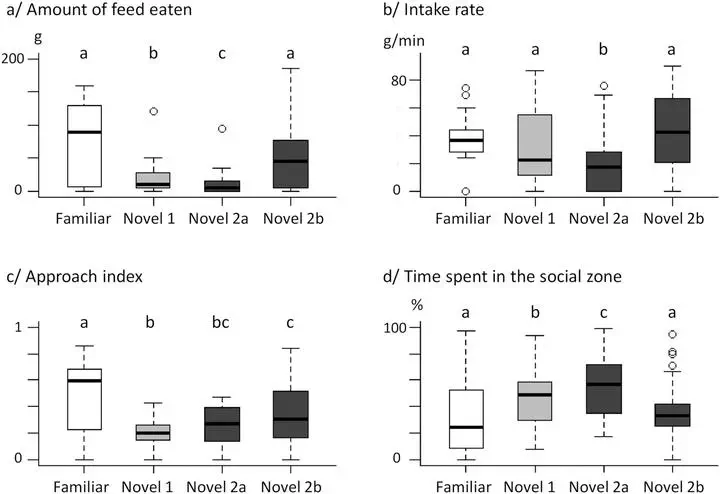
Abstract
Feed neophobia is a reluctance to eat a novel feed that can last from minutes to days. While it can prevent animals from ingesting toxins, it may also have negative effects on growth and animal welfare. In ruminants, feed neophobia has mainly been studied in sheep and cattle, and only a few studies have focused on goats. This study assessed feed neophobia in goats and aimed to determine whether this is breed-dependent. Six-month-old Saanen (n = 18) and Alpine (n = 13) goats were repeatedly placed in an experimental environment, with a familiar feed, for 5 min per day (days 1–7). The familiar feed was then replaced by two novel feeds on consecutive days (d8-d9), and the second novel feed was offered a second time (d10). Saanen goats habituated better to the situation as, on the last day with the familiar feed, they consumed more, with a greater intake rate, and spent less time near conspecifics than Alpine goats. They also showed a higher approach index than Alpine goats, meaning that they spent more time head in the feed trough while being close to it. Breed however did not influence the behavioural responses of goats when they were exposed to novel feeds. When first exposed to the novel feeds and regardless of their respective palatability, the goats reduced their intake compared to when they received the familiar feed, though they sampled the novel feeds by eating small amounts. They also approached the novel feeds less and spent more time near conspecifics. At the 2nd exposure to the second novel feed, the main behavioural responses were reversed, as intake increased and the time spent near conspecifics decreased, to reach the levels recorded with the familiar feed. Only the approach index remained lower. Thus, our results highlight that goats of both breeds displayed feed neophobia when first exposed to different novel feeds, but the situation was reversed after only one short-term exposure. Further research using more novel feeds, different feed-presentation schemes and longer tests will help to improve the understanding of feed neophobia in goats.